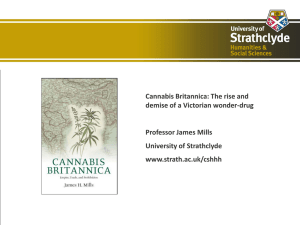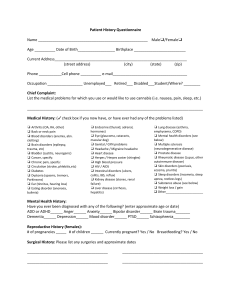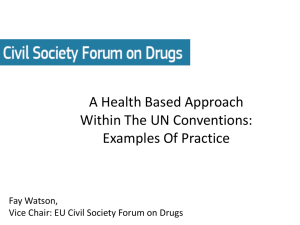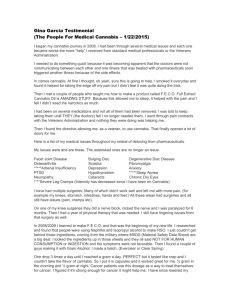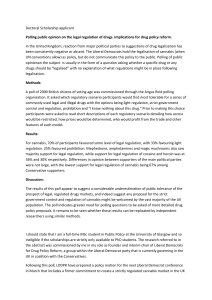Running head: MEDICAL AND ETHICAL CONSIDERATIONS OF
advertisement
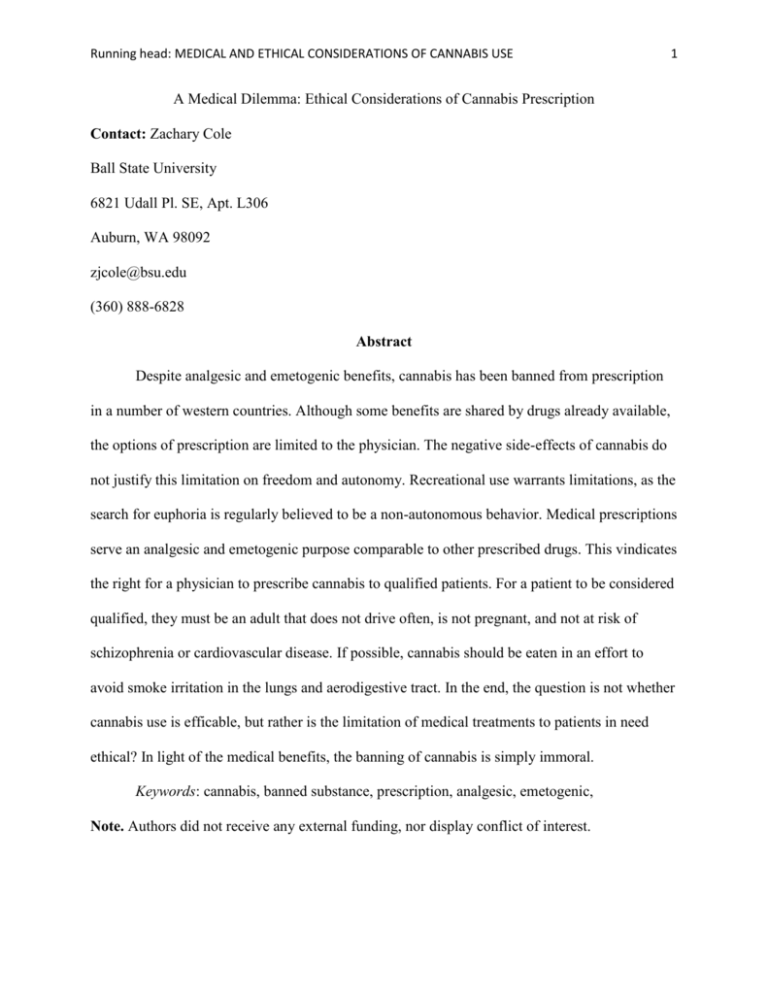
Running head: MEDICAL AND ETHICAL CONSIDERATIONS OF CANNABIS USE 1 A Medical Dilemma: Ethical Considerations of Cannabis Prescription Contact: Zachary Cole Ball State University 6821 Udall Pl. SE, Apt. L306 Auburn, WA 98092 zjcole@bsu.edu (360) 888-6828 Abstract Despite analgesic and emetogenic benefits, cannabis has been banned from prescription in a number of western countries. Although some benefits are shared by drugs already available, the options of prescription are limited to the physician. The negative side-effects of cannabis do not justify this limitation on freedom and autonomy. Recreational use warrants limitations, as the search for euphoria is regularly believed to be a non-autonomous behavior. Medical prescriptions serve an analgesic and emetogenic purpose comparable to other prescribed drugs. This vindicates the right for a physician to prescribe cannabis to qualified patients. For a patient to be considered qualified, they must be an adult that does not drive often, is not pregnant, and not at risk of schizophrenia or cardiovascular disease. If possible, cannabis should be eaten in an effort to avoid smoke irritation in the lungs and aerodigestive tract. In the end, the question is not whether cannabis use is efficable, but rather is the limitation of medical treatments to patients in need ethical? In light of the medical benefits, the banning of cannabis is simply immoral. Keywords: cannabis, banned substance, prescription, analgesic, emetogenic, Note. Authors did not receive any external funding, nor display conflict of interest. MEDICAL AND ETHICAL CONSIDERATIONS OF CANNABIS USE 2 Medical and ethical considerations of cannabis use Discussions of cannabis use within the literature are commonly designated to scientific or moral terms. This dialogue concerns the growing empirical literature with regard to the limited ethical considerations. The current zeitgeist engenders a stigma toward cannabis use, and presumably limits explicit ethical support (Hathaway, Comeau, & Erickson, 2011). While cannabis has roots as a recreational drug, medical benefits relating to pain (analgesic; Campbell et al., 2001; Kalso, 2001; Hall, Degenhardt, & Lynskey, 2001), nausea and vomiting (emetogenic; Tramer et al., 2001; Hall et al., 2001; Kalso, 2001; Hollister, 1986), and anxiety relief have been established (Hall et al., 2001; Hollister, 1986). Nonetheless, the prescription of cannabis has been banned in some western countries (Kassirer, 1997; Hayry, 2004). Although recreational use may not be ethically acceptable, medical and ethical pretexts for banning the prescription of cannabis remain unsubstantiated. A cost benefit analysis of cannabis use must be moderated by ethical considerations of freedom and autonomy of the patient (Hayry, 2004; Kassirer, 1997). Altogether, ethical perspectives maintained by medical evidence support medical cannabis prescriptions to qualified patients. A stigma has been associated with the normification of cannabis use (Hathaway et al., 2011). In light of this normification process, cultural acceptance seems to have thwarted any behavioral aversions to the recreational use of cannabis; as shown by a sample of 200 university students of which over 50% had used marijuana recreationally (Underwood & Fox, 2000). Although illegal cannabis use is releatively common in western culture, this drugs exhibits a negligible effect on society concerning crime and dependency (Hathaway et al., 2011; Husak, 2000). This could be related to the minimal drug supply. If cannabis were marketed and distributed as are alcohol and tobacco, the social impact of this drug use would likely grow MEDICAL AND ETHICAL CONSIDERATIONS OF CANNABIS USE 3 (Hathaway et al., 2011). Another consideration for the lack of social impact may be the acute effects of cannabis use on the mind and body. Cannabis is used recreationally to induce a “high” feeling. This high is a product of the psychoactive ingredient Tetrahydrocannabinol (THC). A cannabis high varies with the method of ingestion. Smoking cannabis results in a euphoric sensation (Hall et al., 2001; Hollister, 1986). This sense of euphoria is generally relaxing (Hall et al., 2001; Hollister, 1986). Other psychoactive effects of cannabis smoking are perceptual alteration, and an intensified sensual experience (Hall et al., 2001). Cannabis is typically smoked, but can also be eaten. This method of ingestion provides a similar, but less intense affective situation (Hall et al., 2001). When cannabis is eaten, the effects are delayed approximately one hour, but the high can last for hours. Smoking or eating too much cannabis at once may have an adverse effect on the high. Negative high experiences with cannabis are usually described as suffering from anxiety, dizziness, dyspnea, hallucinations, and paranoia (Tramer et al., 2001). Although negative aspects of cannabis use may deter medical prescription, certain medical benefits have been substantiated by empirical evidence. Medical Considerations The positive and negative effects of cannabis use are described contextually. In a recreational setting, value is placed on the euphoria. The medical purpose of cannabis is to combat pain or illness. For this reason, medicinal value is measured in terms of efficacy by weighing the costs and benefits of use. This efficacy has also been weighed in comparison with other prescription options. The comparison of cannabis with other drugs brings up an interesting consideration while considering the inferences of research conducted in the not-so-recent past. While the results may MEDICAL AND ETHICAL CONSIDERATIONS OF CANNABIS USE 4 still be relevant, it is important to understand that over time analgesic and emetogenic medical treatments have advanced (Campbell et al., 2001; Kassirer, 1997). Some sources believe that advanced hydroponic nutrients and crossbreeding have increased the potency of cannabis over the past two to three decades (Mckay & Tennant, 2000; Hall et al., 2001). The amplified effect is considered insignificant, and it is actually more likely that a tolerance effect has developed over time, thus increasing the dosage per use (McKay & Tennant, 2000). Evidence for a tolerance build up indicates an opportunity for dependency (Hayry, 2004; Hall et al., 2001; Kalso 2001). This tolerance is associated with a buildup of THC stored in the fatty tissue (Hall et al., 2001). Because THC is not toxic, this buildup is not poisonous and there is no risk of overdose (Kessirer, 1997; Hall et al., 2001). Other long term implications link cannabis use to aerodigestive tract and lung cancer (Hall et al., 2001; Tramer et al., 2001). The aerodigestive tract consists of the oral cavity, pharynx, and esophagus. Because cannabis releases many of the same carcinogens as tobacco, these cancers have been attributed to cannabis smoke (Hall et al., Tramer et al., 2001; Hollister, 1986). Chronic use has also been known to exacerbate already present schizophrenic disorders (McKay & Tennant, 2000; Hall et al., 2001). Empirical evidence identifies cannabis as an effective analgesic, and emetogenic medication. These properties block pain, nausea, and vomiting in patients receiving cancer (Tramer et al., 2001; Campbell et al., 2001) and HIV treatment (Campbell et al., 2001; Kalso, 2001). Although cannabis has a proven therapeutic effect, these properties are shared with alternative opiate and non-steroidal anti-inflammatory treatments (Kalso, 2001). These analgesic properties of cannabis are compared to codeine and benzopyranoperidine (BPP). Empirical research shows cannabis to be similar to codeine, while both drugs are more effective than BPP for pain treatment (Campbell et al., 2001). The emetogenic properties of MEDICAL AND ETHICAL CONSIDERATIONS OF CANNABIS USE 5 cannabis have been compared to prochloroparazine, metoclopramide, chlorpromazine, thiethylperazine, haloperisol, domperidone, and alizapride (Kalso, 2001). These comparisons have found that cannabis is only more effective for treating moderate emetogenic symptoms, extremely high or low emetogenic therapies are better suited for alternative treatments (Tramer et al., 2001). A general increase in heart rate, increased blood pressure while sitting, and decreased blood pressure while standing also indicate cardiovascular stress resulting from the use of cannabis (Hall et al., 2001). For this reason it is recommended that patients suffering from heart disease do not use cannabis. Although health considerations are mostly related to older adults, cannabis shows a mental and physical risk to the development of young children (Lynskey & Hall, 2000; Hollister, 1986; Hall et al., 2001). This begins with cannabis use by pregnant females, which can result in low birth weight (Hall et al., 2001). There is some evidence of stunted physical and social development (Lynskey & Hall, 2000; Hall et al., 2001; Hollister, 1986). Social development relates to the lack of acute and chronic decision making abilities in children that use cannabis (Lynskey & Hall, 2000; Hall et al., 2001). Minors that use cannabis tend to achieve less at school and the workplace (Lynskey & Hall, 2000; Hall et al., 2001). These children also have difficulty respecting authority, and often find themselves in trouble with the law (Lynskey & Hall, 2000; Hall et al., 2001). Although these behaviors are related to cannabis use, a causal connection cannot be made; as minors with behavioral issues may be more prone to use cannabis while underage. Another issue raised with cannabis use is the gateway effect. This states that the use of cannabis increases the likelihood of risky behavior and more serious illicit drug use in the future. Although this effect has been observed, the risk with cannabis is no different than any other drug MEDICAL AND ETHICAL CONSIDERATIONS OF CANNABIS USE 6 (Hall et al., 2001). By ranking drugs from low to high: alcohol, cannabis and other psychoactives, hallucinogens, amphetamines, and cocaine and heroin; express gateway effects at all levels. This is supported by empirical evidence stating that the earlier in life an individual begins one level of drug use increases the likelihood that individual will move up to the next level of drug classification (Hall et al., 2001). This gateway effect is a result of the recreational search for euphoria. For this reason, the gateway effect would not concern patients cannabis prescribed for analgesic or emetogenic purposes. The case has been made that cannabis shows medical benefits, and a slight cancer risk. The short term psychoactive effects of cannabis use also raise concerns. Cannabis use may result in impaired short term memory, reaction time, and motor skills (Hall et al., 2001). Patients may also induce anxiety, depression, dizziness, hallucinations, paranoia, and arterial hypotension while using cannabis (Hall et al., 2001; Campbell et al., 2001). The relative incidence of undesirable psychoactive effects in comparison with alternative opiate and non-steroidal antiinflammatory treatments leave the efficacy of medical cannabis treatments in question. Moral Considerations While a comparison of drug treatments does not indicate that cannabis is decisively more effective for analgesic or emetic treatment when compared to other medications, there is merit in the cannabis alternative. Not only is cannabis a more cost-effective option, but this drug is also completely naturopathic. Considerations such as these are important when appealing to the freedom and autonomy of the patient. Where freedom and autonomy are often times undifferentiated, the following ethical considerations will prove otherwise. Previous ethical consideration of Hayry (2004) concerning cannabis prescription follows the freedom philosophy of John Locke. This freedom is defined as the non-restriction of options MEDICAL AND ETHICAL CONSIDERATIONS OF CANNABIS USE 7 (Hayry, 2004). Although this consideration means that freedom can never truly be accomplished, decisions should be made in an effort to preserve patient freedom. When taking into account the analgesic and emetogenic benefits of cannabis (Campbell et al., 2001; Kalso, 2001; Hall, Degenhardt, & Lynskey, 2001; Tramer et al., 2001), regulations banning prescriptions directly jeopardize the freedom of patients to choose the best fit treatment. Physicians abiding by the principle of freedom are obligated to present the patient with all efficable treatment options (Mepham, 2008). When not allowed, as in the case with banning the prescription of cannabis, the duty of the physician is to notify the authority (Hayry, 2004). While governing authorities became aware of the desire to prescribe cannabis, physicians were warned of inevitable punishment (Kassirer, 1997). Defiance of strained freedom was revealed in surveys administered in the 1990’s indicating 44% of oncologists in the United States had recommended the illegal use of marijuana (Hayry, 2004). Although unlawful recommendations may not be an acceptable ethical alternative, limiting prescription options directly threatens the freedom and autonomy of physicians and patients (Hathaway et al., 2011; Hayry, 2004). Depending on perception, autonomy can be variably defined. In this instance, Hayry (2004) followed the philosophy of Immanuel Kant. In this context, Kant states an individual only experiences freedom of autonomy while free of burdens related to desire, attitude, and emotion (Hayry, 2004). As stated by Immanuel Kant and John Stuart Mill, external effects of behavior should be taken into consideration. This perspective allows for negative circumstances to limit John Locke’s concept freedom (Hayry, 2004). This interpretation of freedom and autonomy prohibits recreational use of cannabis in lieu of the psychoactive properties. MEDICAL AND ETHICAL CONSIDERATIONS OF CANNABIS USE 8 All decisions made should be in an effort to actualize all moral principles. In some cases, the needs of one principle must override another. When considering cannabis use, freedom must be limited when confronted with the possibility of harm to an innocent third party (Hayry, 2004). Possible psychoactive effects of cannabis resulting in physical and mental impairment, and possible dependency create vulnerability in family relationships, workplace safety, and driving impairment (Hayry et al., 2004; Hall et al., 2001). These same effects apply to opiates, and other prescribed psychoactive drugs (Hall et al., 2001; Hollister, 1986). Such considerations may apply in a recreational setting whereas a medical environment controls these effects (Hayry et al., 2004). A recreational setting may also provide minors with access to cannabis. Minors are not capable of making informed decisions. Drug use in a recreational setting may confuse and corrupt impressionable minds into making decisions that could result in harmful consequences (Hayry et al., 2004; Hollister, 1986). As with other prescription drugs, a medical setting controls this possible complications related to illicit drug use. Banning the prescription of a beneficial drug limits the ability of the physician to provide medical assistance to the patient. Because the physician is interested in the well-being of the patient (Hayry, 2004; Mepham, 2008), and considered a medical expert, banning the prescription of cannabis limits the freedom and autonomy of both the patient and physician. Although autonomy and freedom exhibit different principle influences on the decision making of physicians and patients, these principles are not entirely independent. From an ethical perspective, while exhibiting the minor possibility of dependency, cannabis is a viable option for medical treatment of analgesic or emetogenic ailments. In light of these medical functions, it has been recommended that cannabis be reclassified by the DEA from MEDICAL AND ETHICAL CONSIDERATIONS OF CANNABIS USE 9 a Schedule 1 drug (addictive, no medical use), to a Schedule 2 drug (potentially addictive, medical use; Kassirer, 1997). When confronted with this case, the DEA judge stated in support, “It would be unreasonable, arbitrary, and capricious for DEA to continue to stand between those sufferers and the benefits of this substance in light of the evidence in this record” (Kassirer, 1997, p. 366). Hypocritical instances indicate “misguided, heavy-handed, and inhumane” (Kassirer, 1997, p. 366) motives controlling legislation. This morally wrong act steals the principles of freedom and autonomy from others. Hayry (2004) encapsulated this by stating, “others are trying to ‘Play God’ if they insist their claims and beliefs should override our choices” (p. 334). Recommendations Observing the medical efficacy and moral judgment of cannabis prescription, it is my opinion that qualified patients should be free to choose cannabis as a form of treatment for analgesic, emetogenic, and anxiety related conditions. Qualified patients are adults capable of making informed decisions, not suffering from any cardiovascular conditions, and have no history of schizophrenia. If possible, prescribed cannabis should be eaten to avoid the chronic effects of smoke inhalation while taking advantage of a longer lasting high. Patients that drive often should consider alternatives to cannabis treatment. Children and pregnant females should under no circumstances receive a cannabis prescription. Although medical prescription is prefaced by a conditional need; relative efficacy and personal judgments or beliefs should not be a criteria for defining the choice freedom of medical patients and physicians. The concern of treatment is not with the efficacy of cannabis, but in the improved health and well-being of the patient. MEDICAL AND ETHICAL CONSIDERATIONS OF CANNABIS USE 10 References Campbell, F. A., Tramer, M. R., Carroll, D., Reynolds, J. M., Moore, A., & McQuay, H. J. (2001). ‘Are Cannabinoids an Effective and Safe Treatment Option in the Management of Pain? A Qualitative Systematic Review’. British Medical Journal, 323: 13-16. Hall, W., Degenhardt, L., & Lynskey, M. (2001). The Health and Psychological Effects of Cannabis Use (2nd ed.). Canberra ACT 2601: Commonwealth of Australia. Hathaway, A. D., Comeau, N. C., & Erickson, P. G. (2011). ‘Cannabis Normalization and Stigma: Contemporary Practices of Moral Regulation’. Criminology and Criminal Justice, 11(5): 451-469. Hayry, M. (2004). ‘Prescribing Cannabis: Freedom, Autonomy, and Values’. Journal of Medical Ethics, 30: 333-336. Hollister, L. E. (1986). ‘Health Aspects of Cannabis’. Pharmacological Reviews, 38(1): 1-20. Husak, D. N. (2000). ‘Liberal Neutrality, Autonomy, and Drug Prohibitions’. Philosophy and Public Affairs, 29(1): 43-80. Kalso, E. (2001). ‘Cannabinoids for Pain and Nausea: Some Evidence But is there any Need?’ British Medical Journal, 323: 2-3. Kassirer, J. P. (1997). ‘Federal Foolishness and Marijuana’. The New England Journal of Medicine, 5: 366-367. Lynskey, M., & Hall, W. (2000). ‘The Effects of Adolescent Cannabis Use on Educational Attainment: A Review’. Addiction, 95(11): 1621-1630. McKay, D. R., & Tennant, C. C. (2000). ‘Is the Grass Greener? The Link between Cannabis and Psychosis’. Medical Journal of Australia, 172: 282-284. MEDICAL AND ETHICAL CONSIDERATIONS OF CANNABIS USE 11 Mepham, B. (2008). Bioethics: An Introduction for the Biosciences (2nd ed.). New York, NY: Oxford University Press Inc. Tramer, M. R., Carroll, D., Campbell, F. A., Reynolds, J. M., Moore, A., & McQuay, H. J. (2001). ‘Cannabinoids for Control of Chemotherapy Induced Nausea and Vomiting: Quantitative Systematic Review’. British Medical Journal, 323: 16-21. Underwood, B. & Fox, K. (2000). ‘A Survey of Alcohol and Drug Use among UK Based Dental Undergraduates’. British Dental Journal, 189(6): 314-317.


